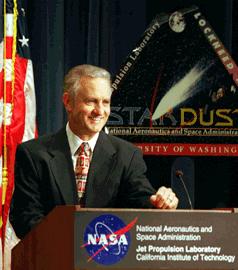STARDUST Status Report
February 26, 1999

Ken
Atkins
STARDUST Project Manager
Things continue to go very well aboard STARDUST. The spacecraft is now in
"Cruise 1" mission phase. The tracking schedule with the Deep Space Network
(DSN) antennas around the world has been dropped from continuous tracking
to two 4-hour data transmission periods per day. This tracking schedule
will be continued until readiness is established for the "routine" cruise
mode of one 4-hour tracking period per week. In the current two-period
tracking schedule, the flight team is completing checkout and testing of
all STARDUST subsystems and watching for any performance trends.
As noted last week, the Dust Flux Monitor (DFMI) was turned on Friday for
engineering tests and all went well. Operating in science mode, it got a
"particle hit" over the weekend and has continued to register additional
"impacts" this week The indications are believed to be reactions to
firings of the attitude control thrusters. The flight team will examine the
firing history of the thrusters to see if the timing matches the occurrence
of the DFM events.
The Cometary and Interstellar Dust Analyzer (CIDA) was activated and
initial testing went very well. Continuing to the second testing phase
indicated that the computer and flight software need to be adjusted to
allow time for CIDA to accept commands before responding with data.
For DFMI and CIDA, the Ground Data System (GDS) and Data-management and
Analysis (DM&A) have provided telemetry data to the scientists for
near-real time review. End-to-end data flow could not be better. This
indicates a good situation for the scientists to get information when real
science investigations start later. The CIDA Team will start looking for
interstellar particles to hit their instrument beginning in April and
continuing through July. So, there's a lot of action coming up in the near
future.
Current plans are to turn on the Navigation Camera on March 26. The initial
check out will include moving the scan-mirror away from sighting directly
through the periscope, and then taking some images to calibrate the camera.
It's clear there's still a lot of "flyers" out there interested in the
flight status. In the past week, the home page hit a peak of 128,629 hits
and has been averaging 110,000 hits/day for the week.
Be sure to "stay tuned" and check out the following new photos:
18 Additional Launch Photos
http://stardust.jpl.nasa.gov/photo/launch1.html
High-Res Aerogel Photos (brick & hand)
http://stardust.jpl.nasa.gov/photo/aerogel.html
For more information on the STARDUST mission - the first ever comet sample
return mission - please visit the STARDUST home page:
http://stardust.jpl.nasa.gov
